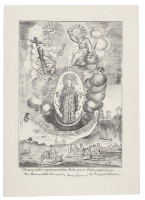
Our Lady of Grace of Antakalnis. Plague in Vilnius in 1710
| Authors: |
Franciszek Pelikan (ca 1778–1781) Ignacy Karęga Józef Perli (?–1818) |
| Created: | 1799 |
| Material: | paper |
| Technique: | copper engraving |
| Dimensions: | 35.40 × 25.30 cm |
| Signature: | inscription on the wrapper: Obraz MARYI Łaskawey w Kosciele Kañonikow Zakonnych / w Wilnie na w Przedmiesciu Antokolskim mieszkaiących Dobrodzieystwy słynący Bottom inscription and signature: Okropny widok srogiego powietrza Roku 1710 w Wilnie grassuiącego / Fran Pelikan uczeń Akadm Wilens: rysował / X. Karęga Grawirował / Jozef Perł wybijał w Wilnie Ru: 1799 |
This is an engraving of the painting of Our Lady of Grace presented in 1653 to the Lateran Canons’ Church of St Peter and Paul in Antakalnis by Jerzy Tyszkiewicz, the Bishop of Vilnius. Mary is holding in both her hands the broken arrows of God’s wrath pointed by his Son at the Earth to punish sinners and non-believers. Our Lady of Grace of Antakalnis was believed to protect the people of Vilnius at dangerous moments in history, during wars and plagues. In the engraving, the wrathful Jesus Christ, together with God the Father and God the Holy Spirit, are portrayed above the Blessed Virgin Mary, and a somewhat primitive portrayal of the 1710 plague is included at the bottom with an image of dying townspeople and those taking care of them. We can recognise in an empty-looking Vilnius the silhouettes of the Three Crosses, the Upper Castle, and the towers of the Church of St Peter and Paul in Antakalnis.
Text author Dalia Vasiliūnienė
Source: Law firm Valiunas Ellex art album HEAVEN AND BEYOND (2016). Compiler Dalia Vasiliūnienė. Text authors Dalia Vasiliūnienė, Skaidrė UrbonienėExpositions: "Vilnius Time", 5 June 2023 – 1 May 2024, Lithuanian Art Centre TARTLE (Užupio St. 40, Vilnius). Curators Ieva Burbaitė and Emilija Vanagaitė.







